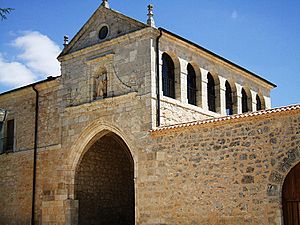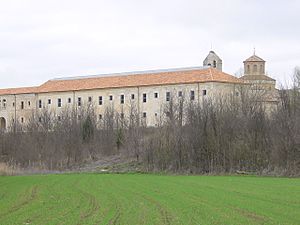Valbuena Abbey facts for kids
The Valbuena Abbey (also known as Monasterio de Santa María de Valbuena) is a very old monastery in Valbuena de Duero, Valladolid Province, Spain. It was once home to Cistercian monks. This beautiful building stands right by the Duero River. From the abbey, you can even see the historic Peñafiel Castle.
Contents
History of the Abbey
How Valbuena Abbey Started
The Valbuena Abbey was built a long, long time ago, in 1143. A woman named Estefanía, who was the daughter of Count Ermengol V of Urgell, helped start it. Monks from another abbey in France, called Berdoues Abbey, came to live here.
Growing and Helping Other Abbeys
The first leaders of the abbey were Martin and Ebrardo. Valbuena Abbey quickly became important. It even helped start three other abbeys! These were Rioseco Abbey in 1148, Bonaval Abbey in 1164, and Palazuelos Abbey in 1169.
Changes Over Time
In the 1300s, the abbey became less active. For a long time, it was connected to Berdoues Abbey in France. But in 1430, it became part of a Spanish group of Cistercian abbeys. Later, in 1835, the government decided to close many religious places, and Valbuena Abbey was one of them.
New Uses for the Abbey
After it closed, the church part of the abbey became a local parish church. For a short time in 1939, during a difficult period in Spain, parts of the monastery were used as a place where people were held. Later, the other buildings were sold to private owners.
In 1931, the monastery was recognized as a very important national monument. This meant it was protected. In the 1950s, a government group bought the land around the monastery. They built a new town nearby for people who had to move from their homes because of a new dam.
Restoring and Protecting the Abbey
From the mid-1950s to the late 1960s, a lot of work was done to change and fix up the buildings. In 1966, the abbey was sold to the Archdiocese of Valladolid, a religious organization.
Around 1990, the abbey was given to a religious foundation called Las Edades del Hombre. Since then, many projects have worked to restore the old buildings. A Spanish architect named Pablo Puente Aparicio helped with these renovations in the 1990s. In March 2000, the government of Castile and León officially named the monastery of Santa Maria de Valbuena a National Heritage site. This means it is a very important part of Spain's history and culture.
Buildings and Site
Main Parts of the Abbey
Most of the buildings you see today were finished by 1230. The main parts include the church, which started being built in 1149. There are also buildings where the monks lived and worked. There was even a special area for guests.
The Church's Design
The church has three long sections called aisles. It has a special ceiling design called a groin vault. The main part of the church, where the altar is, has a large, rounded end called an apse. There are also two smaller rounded sections on the sides. In 1165, a rectangular side-chapel was added. The front of the church has a pointed arch doorway. Above the door, there is a large round window called an oculus.
Other Important Rooms
The chapter house, where monks met, and the day room also have groin-vaulted ceilings. The refectory, which was the dining hall, has a pointed barrel-vaulted roof. The cloister, which is a covered walkway around a courtyard, has two levels.
There is a special room called the Capilla San Pedro (St. Peter's Chapel). It has a special arched tomb with a painting of a king from around 1270. In later years, a part of the building for lay brothers (people who helped the monks but were not priests) was removed to make space for another courtyard. By the river, you can still see the ruins of the abbot's house, which was built in the 1500s.
The abbey was officially declared a national monument in 1931.
See also
 In Spanish: Monasterio de Santa María de Valbuena para niños
In Spanish: Monasterio de Santa María de Valbuena para niños




